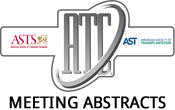Paradoxical Differential Post-transplant Rates Of Change Of Serum Proteins In Pediatric Liver Patients With Evidence For A Novel Sarcopenic-dependent Serum Protein Stimulating Factor
C. M. Schmidt1, J. Molleston2, G. S. Rao2, C. A. Kubal1, S. Atoa1, R. S. Mangus1
1Surgery, Transplant Division, Indiana University, Indianapolis, IN, 2Pediatrics, Division of GI and Hepatology, Indiana University, Indianapolis, IN
Meeting: 2019 American Transplant Congress
Abstract number: B72
Keywords: Liver transplantation, Metabolic complications, Risk factors
Session Information
Session Name: Poster Session B: Biomarkers, Immune Monitoring and Outcomes
Session Type: Poster Session
Date: Sunday, June 2, 2019
Session Time: 6:00pm-7:00pm
 Presentation Time: 6:00pm-7:00pm
Presentation Time: 6:00pm-7:00pm
Location: Hall C & D
*Purpose: Pediatric patients with liver disease suffer from hypoalbuminemia, sarcopenia, and malnutrition. This study aims to quantify differential rates of change (ROC) and post-TX normalization of nutritional markers (ALB, body mass index (BMI), and body weight (BW)) with subgroup analysis of patient pre-TX baseline nutritional status (fat stores, muscle mass (MM), BMI, and ALB) and patient demographics.
*Methods: A retrospective review of nutritional markers in a prospectively collected transplant database (2001-2018) at a single center was performed. Those with CT imaging pre- or post-TX were subject to scaled scoring by dividing cross sectional area measures of the psoas muscle at the L2/L3 intervertebral space by height2 for MM, and visceral and subcutaneous fat. ANOVA was used to compare patient subgroups.
*Results: There were 114 patients who met study criteria, 82 with CT imaging analysis. Pre-TX, 45% had severe sarcopenia. ALB normalized at a median time of 5 wks for everyone. Those with lower baseline ALB had an increased median time to normalization of ALB (P<0.01). Median ALB levels lagged significantly in those aged <2 at multiple time points (p<0.05) with a markedly less steep ROC overall. Median ALB levels were significantly higher in wk 8 of patients with BMI>23 (p<0.05) with a markedly steeper ROC overall. A gradual positive ROC for BMI and BW was seen in those aged < 11 whereas those aged ≥ 11 had an acutely negative drop in both in the first 30 days and an overall negative ROC. Weekly median ALB by MM showed no significance when grouping with ANOVA by our 3 levels of sarcopenia, but clearly there is a paradoxical increased ROC in severe sarcopenia patients if compared to mild/no sarcopenia.
*Conclusions: Liver TX dramatically reverses hypoalbuminemia at differential ROC according to age and pre-TX BMI and ALB levels. Despite normalization, liver TX does not dramatically change BW and BMI. Those that struggle resolving their hypoalbuminemia are infants, and those with low pre-TX BMI and ALB. Paradoxically, severe sarcopenia patients median ALB levels remained the highest throughout most of the first 7 weeks and showed a markedly increased ROC compared to the mild/no sarcopenia. We speculate a novel “serum protein stimulating factor” may exist in severe sarcopenic patients. Understanding the differences in post-TX normalization rates according to pre-TX nutritional status, and demographic differences in this population may reveal clues to discoveries to optimize their care.
To cite this abstract in AMA style:
Schmidt CM, Molleston J, Rao GS, Kubal CA, Atoa S, Mangus RS. Paradoxical Differential Post-transplant Rates Of Change Of Serum Proteins In Pediatric Liver Patients With Evidence For A Novel Sarcopenic-dependent Serum Protein Stimulating Factor [abstract]. Am J Transplant. 2019; 19 (suppl 3). https://atcmeetingabstracts.com/abstract/paradoxical-differential-post-transplant-rates-of-change-of-serum-proteins-in-pediatric-liver-patients-with-evidence-for-a-novel-sarcopenic-dependent-serum-protein-stimulating-factor/. Accessed December 7, 2025.« Back to 2019 American Transplant Congress

